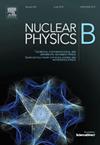Barrow entropy effects on thermodynamics and quasi-periodic oscillations around a Frolov black hole
IF 2.5
3区 物理与天体物理
Q2 PHYSICS, PARTICLES & FIELDS
引用次数: 0
Abstract
This study investigates the geometric structure, particle dynamics, and thermal properties of the non-rotating Frolov black hole. We analyze the black hole geometry and derive the effective potential governing the motion of the test particle, showing the influence of the BH charge Q and the parameter α on the motion of the particle. Using the Hamiltonian formalism, we determine the angular momentum, energy, and innermost stable circular orbits of the particles, demonstrating that increasing Q and α shifts the innermost stable circular orbit radii closer to the horizon and reduces the stability of the orbit. The effective force acting on the particles becomes more attractive with higher Q and α. Harmonic oscillatory motion around stable orbits reveals distinct radial, latitudinal, and axial frequencies, which diminish near the horizon for larger Q and α. Periastron precession rates similarly decrease with these parameters. The center of mass energy near the horizon escalates with Q and α, suggesting enhanced energy extraction efficiency. We also study the black hole thermodynamics, and found that the black hole exhibits a positive Hawking temperature and entropy, while the specific heat analysis indicates phase transitions and regions of stability dependent on Q, α, and the Barrow entropy parameter. The emission energy rates decrease as Q and α increase. Our results generalize the Schwarzschild black hole case () and provide critical insights into the interplay between charge, space-time structure, and thermodynamic behavior in Frolov black hole geometries.
热力学中的巴罗熵效应和Frolov黑洞周围的准周期振荡
本文研究了非旋转Frolov黑洞的几何结构、粒子动力学和热性质。我们分析了黑洞的几何形状,推导了控制测试粒子运动的有效势,显示了黑洞电荷Q和参数α对粒子运动的影响。利用哈密顿公式,我们确定了粒子的角动量、能量和最内层稳定的圆轨道,证明了增加Q和α使最内层稳定的圆轨道半径更接近视界,并降低了轨道的稳定性。作用在粒子上的有效作用力随着Q和α的增大而增大。围绕稳定轨道的谐波振荡运动显示出明显的径向、纬度和轴向频率,当Q和α较大时,这些频率在视界附近减小。近星进动率也随着这些参数的减小而减小。视界附近的质心能量随着Q和α的增大而增大,表明能量提取效率提高。我们还研究了黑洞热力学,发现黑洞表现出正的霍金温度和熵,而比热分析表明相变和稳定区域依赖于Q、α和Barrow熵参数。发射能率随Q和α的增大而减小。我们的研究结果推广了史瓦西黑洞的情况(Q=α=0),并对Frolov黑洞几何中电荷、时空结构和热力学行为之间的相互作用提供了重要的见解。
本文章由计算机程序翻译,如有差异,请以英文原文为准。
求助全文
约1分钟内获得全文
求助全文
来源期刊

Nuclear Physics B
物理-物理:粒子与场物理
CiteScore
5.50
自引率
7.10%
发文量
302
审稿时长
1 months
期刊介绍:
Nuclear Physics B focuses on the domain of high energy physics, quantum field theory, statistical systems, and mathematical physics, and includes four main sections: high energy physics - phenomenology, high energy physics - theory, high energy physics - experiment, and quantum field theory, statistical systems, and mathematical physics. The emphasis is on original research papers (Frontiers Articles or Full Length Articles), but Review Articles are also welcome.
 求助内容:
求助内容: 应助结果提醒方式:
应助结果提醒方式:


